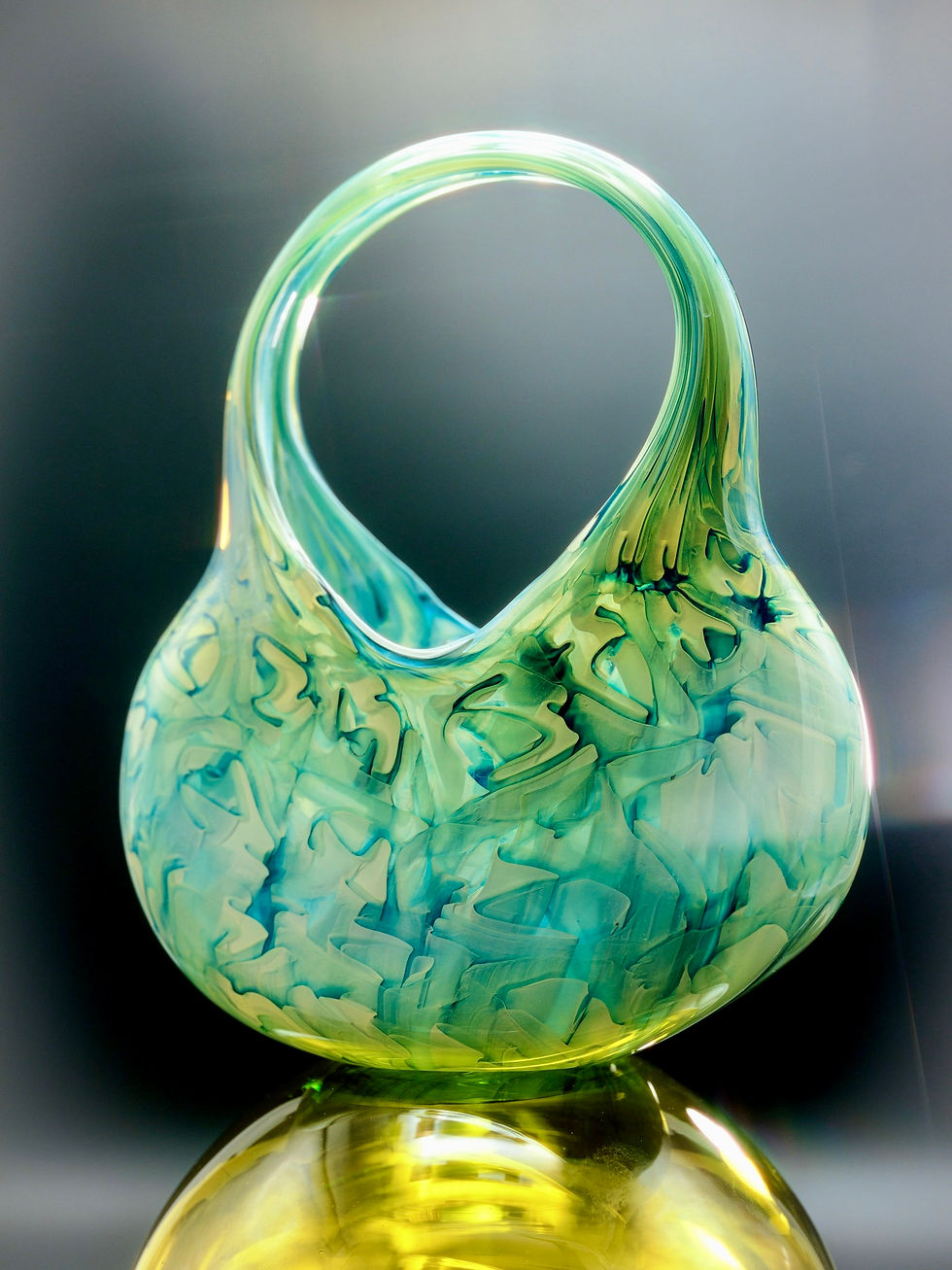Let's Raise A Glass To Joshua Raiffe
- Rachel Huss
- Mar 3
- 4 min read

“The purpose of art is washing the dust of daily life off our souls.” — Pablo Picasso.
This quote resonates as I reflect on how art, especially glass art.. In today’s world, efficiency and functionality often dominate our thinking. Mainstream products, views, and conventions are exalted, and many find themselves consumed by the endless pursuit of approval in the form of fleeting “fulfillment.” But if this is our reality, where can we find meaning? Where can we breathe in fresh, transformative ideas? The answer is simple: art—particularly art that disrupts the ordinary, like glass art.
Art can uplift our thoughts, challenge our perceptions, and reflect the artist’s unique reality. This is especially true with glass, which is not just a medium for utility—it’s an art form that transforms the everyday into something extraordinary. Traditionally, glass serves a practical purpose—protecting, containing, and revealing—but as an art medium, it becomes a canvas for self-expression and innovation.
Joshua Raiffe is a pioneering force in glass art, ushering in a new era where function meets bold artistic expression. His innovative redefinitions of vases, accessories, and more have captivated a new generation, pushing glass art into exciting, unexplored territories.
I spoke with Joshua Raiffe, glass artistic pioneer, to learn about his artistoc philosophy.

Interview with Joshua Raiffe, The Glass Artist

1. What is art?
Art is a means of expression, a way to communicate ideas, emotions, and narratives. For me, it's about pushing boundaries—challenging how we perceive our lives and who we are. I like it when art makes me a little uncomfortable. Art is about curiosity and exploration, constantly redefining itself through the hands and minds of those who create it.
Juxtaposed with craft, the value of art lies in its ability to create an experience, illicit strong emotions, tell a meaningful story, or communicate a powerful message. Glass has a strong reputation for being a craft material. It takes many years of hard work to be proficient with it. Within the glass community, being a good craftsperson is very respectable. Unlike art, the value of craft lies primarily in the craftsmanship of the piece and how well it's made. This gives the craft a less intellectual and shallower reputation than art, which is unjustified. Works of craft can still tell a powerful story, hold wisdom, or move a viewer to tears.
2. What makes your art different from other glass sculptures?
My work sits at the intersection of sculpture and fashion, blending traditional glassblowing techniques with contemporary design to create visually striking and functional pieces. Glass is often seen as fragile and static. Still, I challenge that perception by transforming it into something wearable and dynamic. My glass bags, for instance, aren't just objects; they tell a story about luxury, craftsmanship, and the unexpected ways materials can be reimagined.
Every time someone wears one of my bags, we become collaborators. The wearer brings their own style, confidence, and personality to the bag. In return, the bag also gives the wearer style and confidence. The event to which it's brought provides the bag with a story and a history. I love imagining a young granddaughter finding one of my bags in her grandmother's attic. Her mother says, "Your grandmother was eccentric; she wore this to your aunt's wedding. It caused a huge argument, and your Grandpa Bob ended up getting a divorce."
3. How has your work evolved since you began glassblowing?
When I first started, I was focused on mastering the technical aspects of glassblowing—understanding the material, its limits, and possibilities. Over time, I've developed a more conceptual approach, using glass as a medium for storytelling.
My work has always focused on relationships. I used to make two separate objects and try to communicate a complex human relationship between them. I do a similar thing now, but one of the objects I'm using is an actual person, the wearer of my bag.
I'm not satisfied with the current state of my work. It's not scary enough; it's too beautiful and easy. In the fashion world, I see how it is boundary-pushing, and my background gives me a unique voice that is fresh for the fashionista. But in sculpture, my art has so much more potential to shock and leave a lasting impression on people.
A new hurdle I am facing is combating the pull of public approval and money. Only in the last three years have I been able to support myself entirely by selling my art. This introduces the toxic incentive to sell work I know the public will approve of, which is a death sentence for new and interesting art.

4. How do you incorporate your mission and vision into your work?
My goal is to challenge conventional notions of glass art and fashion. I want people to see glass as more than just a fragile or decorative material—it can be bold, wearable, and even subversive. Every piece I create extends that vision, questioning what's possible with glass and inspiring a dialogue between craftsmanship, design, and contemporary culture.

5. What advice would you give to young artists?
Experiment relentlessly. Find your voice by pushing the limits of your ideas and your comfort. Don't be afraid to fail—every mistake teaches you something valuable. And most importantly, stay true to your vision. Trends come and go, but originality and authenticity will always stand out.
6. What's your next chapter?
I'm constantly exploring new ways to evolve my work, whether through collaborations, new materials, or expanding the scale of my pieces. I'm particularly interested in integrating glass with other unexpected elements and pushing further into the intersection of art and fashion. The goal is to keep redefining what's possible—for myself and the medium of glass itself. Alternatively, I might quit this endeavor and become a board game designer. I've got an excellent prototype of a hot new game.









Comments